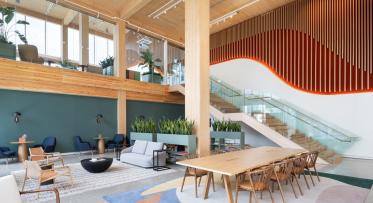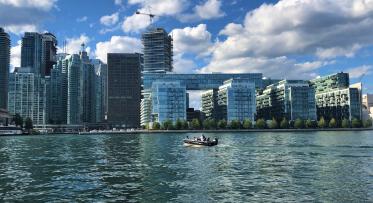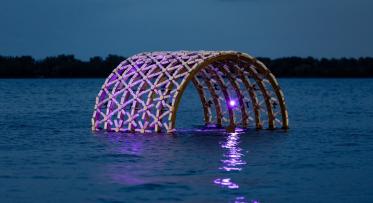Town Hall Recap: 5 highlights about the future of waterfront revitalization
Stakeholders dropped by George Brown College’s health sciences campus on Tuesday, June 6 to learn about the next phase of waterfront revitalization at Waterfront Toronto’s 2017 Town Hall.
POSTED: JUNE 15, 2017 I ECONOMIC DEVELOPMENT, INFRASTRUCTURE, INNOVATION, DESIGN, PARKS AND PUBLIC SPACES, PUBLIC ART, SUSTAINABILITY, TRANSPORTATION, WALKABLE NEIGHBOURHOODS
BY: ALISSA RANDALL
As Waterfront Toronto enters the second phase of waterfront revitalization, there are new transformational projects on the horizon. On Tuesday, June 6, more than 240 people joined us at a public town hall where our CEO, Will Fleissig updated the community on our evolving mandate, new strategies and the major projects that will define the waterfront’s future.
If you weren’t able to join us, here are five highlights you'll want to know about.
1. We’re changing in response to new challenges and opportunities.

The second era of waterfront revitalization will leverage development opportunities like Quayside and the Port Lands to address the challenges of climate change, inclusivity, mobility, affordable housing and economic growth. It will also showcase innovative Canadian technology, design excellence and sustainability practices for other cities to follow.
Over the past 15 years, the Greater Toronto Area has been experiencing unprecedented growth. With this growth comes a greater demand for new places to live and work.
Alongside this, we need more green spaces, recreation spaces, trails and transit connections to serve our downtown residents, workers and the tourists who visit our city. At the same time, we are facing unprecedented challenges: Looming climate change, a public transit system that is over capacity, a crisis of housing affordability, and an economy that continues to shift toward the tech, finance and creative sectors while traditional manufacturing declines.
With all these things in mind, we’re reexamining our strategy and priorities to ensure that Waterfront Toronto is poised to effectively address these challenges. We are seeking out new kinds of partnerships that will support our vision of complete waterfront communities that are healthy, livable, vibrant and sustainable.
We want the second era of our waterfront revitalization to continue to create great urban neighbourhoods and spaces, while addressing the issues of climate change, social inclusion, public transit and accessibility for all to work, live and play.
You can find more information about our future direction in our 2017/18 Corporate Plan.
2. Quayside will be a model urban 21st century neighbourhood:

An artist rendering shows, in white, the massing and scale proposed for Quayside. This new 21st century neighbourhood is an opportunity to test and demonstrate advanced technologies, building projects and innovative solutions for climate positive urban development.
Cities around the world are facing the dire challenge of climate change and a demand for more inclusive, affordable housing. Waterfront Toronto is on a mission to create a precedent-setting waterfront community called Quayside to address these ongoing challenges and demonstrate global leadership and new models for building future urban communities.
Quayside will act as a testbed for new technologies, strategies and partnerships that will respond to these evolving challenges. We hope that Quayside will be an urban model 21st century neighbourhood that will be replicated by cities worldwide to encourage climate-positive development.
Our key objectives for this community includes creating a new market model for climate-positive development by piloting leading sustainable and resiliency practices that address Canada’s aggressive carbon emission reduction targets. We also want to incorporate advanced technologies for better productivity and enhance the overall life of residents, workers, students and visitors to the area. One of the ways in which are doing this with Canada’s first-open access, ultra-high speed internet that delivers internet connection speeds much faster than standard networks.
Secondly, we want to establish “complete communities” by creating housing for all family sizes and income levels with a mix of uses such as public open space, retail, culture, recreation, etc. We also want Quayside to spur economic growth and prosperity for Canada’s cleantech, building materials and innovative sectors to support their growth in global markets. We are currently looking for an Innovation and Funding partner to help create this exceptional vision, a partner that will help us think, plan, engage, test and build a community that will produce new regional, national and global city-building models. We expect to make an announcement about this partnership in mid-Autumn.
3. Mixed-income housing is the future for waterfront communities.

The future Bayside community will be host to affordable rental housing units integrated within market condominiums and the broader community.
Toronto is facing a housing affordability crisis. With an overheated real estate market, increasingly rent and housing costs are rising faster than wages. This is one of the key concerns expressed by stakeholders at the town hall.
We're ensuring that 20 per cent of all residential units being built in our new waterfront communities will be affordable rental housing. An additional 5 per cent will be priced at the low end of market rates. We believe in creating an inclusive, diverse and equitable community designed for everyone. Already, in the West Don Lands neighbourhood, we’ve helped to create three new affordable rental developments with Toronto Community Housing, Fred Victor and Wigwamen.
Going forward, we’re looking at new models for building even more affordable housing. Working with our partners at Hines/Tridel, their upcoming Aquavista development in the Bayside neighbourhood will have 80 units of affordable rental housing operated by Artscape.
As we plan our urban communities, we are also thinking about how to accommodate residents who are concerned about accessing more affordable neighbourhood amenities downtown such as retail and grocery stores. These are important conversations that are ongoing with the City of Toronto.
4. The Port Lands Flood Protection project will spur future development.

The future of Toronto’s Port Lands will see these large post-industrial lands revitalized, adding billions in revenue to the Canadian economy, and creating new jobs, new housing and new expanses of natural green space.
No other city in North America has such a massive piece of under-developed land, just a short commute away from the downtown core. The Port Lands is a 400 hectare (880 acres) piece of downtown waterfront land that was once part of the largest wetlands on Lake Ontario. Today, it is an underutilized and contaminated brownfield site.
Unlocking development in the Port Lands will create tremendous value for the city. We aim to transform these post-industrial lands into new sustainable waterfront communities that spur innovation, economic growth and create jobs. Before that can happen, it is crucial that the site is flood protected first.
The Port Lands Flood Protection project will create a new mouth for the Don River, restore wetlands, create parks and open spaces and lessen the risk and costs associated with major flooding.
We expect construction of the Flood Protection to take seven years. When complete, we’ll be able to build new waterfront communities in the Port Lands.
Our government partners are currently reviewing the project and we hope to have the funds in place to begin construction later this year.
5. Making progress on the master plan for the Jack Layton Ferry Terminal and Harbour Square Park

Phase 1, the first component of the Jack Layton Ferry Terminal master plan, will begin construction in 2017/2018. This initial phase includes design and construction of the entrance plaza, wayfinding signage, and an extension of the Queens Quay pedesterian promenade from Bay Street to the Ferry terminal entrance.
The Jack Layton Ferry Terminal is the gateway to one of Toronto’s favourite summer spots and one of our most important parks – the Toronto Islands. More than 1.34 million residents and tourists use the terminal annually. Over time, our master plan for the ferry terminal and neighbouring park will transform this important waterfront transportation hub into the iconic landmark it deserves to be.
The first phase of the master plan includes extending a new pedestrian promenade from Queens Quay and Bay Street south towards the entrance of the Ferry Terminal, providing an easier connection to get to the terminal. Wayfinding signage will be installed along with new lighting throughout the park. These components provide a more inviting and welcoming gateway for residents and tourists of all ages to enjoy. Construction is scheduled to begin in late 2017.
Eventually, a new terminal building will be built to accommodate the crowds of residents and tourists who ride the ferries every summer. The new building will be designed to enhance accessibility and improve the ferry service. Additionally, Harbour Square Park will become a signature waterfront park that connects to the new terminal building and offers stunning views of the lake.
Missed our townhall? You can watch it on Waterfront Toronto’s Facebook page: www.facebook.com/WaterfrontToronto/
You can also view an FAQ document here.




